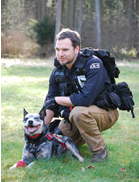Exploring the Advantages and Caveats of Using Conservation Detection Dogs

Heath Smith
University of Washington, Center for Conservation Biology, Conservation Canines Program
heath623@uw.edu
A noter : Présence d'un chien lors de la présentation
Some of the most pressing conservation issues require scientists to distinguish between multiple, concurrent pressures faced by wildlife over large geographic ranges. The Conservation Canines program addresses this need by combining the precision and efficiency of detection dogs to readily locate wildlife scat (feces) samples, from which can be extracted a wide variety of genetic, physiological, toxicological and dietary indicators. These indicators enable us to ascertain species abundance, distribution, resource use, and physiological health in relation to the environmental pressures the species is encountering. The Center for Conservation Biology has been using detection dogs since 1997 to non-invasively monitor a very diverse array of threatened and endangered wildlife species around the world (including bears, owls, mice, salamanders, sea turtles, bats, snakes, orcas, etc…) as well as to detect invasive plants. The Center’s lead trainer, Heath Smith, will look back over the past 14 years to discuss the many benefits and hidden hurdles of employing dogs in conservation efforts.
Recent publications:
SK Wasser, L Hayward, J Hartman, R Booth, K Broms, J Berg, E Seely, L Lewis, H Smith. 2012. Using Detection Dogs to Conduct Simultaneous Surveys of Northern Spotted (Strix occidentalis caurina) and Barred Owls (Strix varia). PLoS ONE 7(8): e42892.
SK Wasser, JL Keim, ML Taper, SR Lele. 2011. The influences of wolf predation, habitat loss, and human activity on caribou and moose in the Alberta oil sands. Frontiers in Ecology and the Environment 9: 546–551.
C Vynne et al. 2010. Effectiveness of scat-detection dogs in determining species presence in a tropical savanna landscape. Conservation Biology 25(1): 154-162.
SK Wasser, H Smith, L Madden, N Marks, C Vynne. 2009. Scent Matching Dogs Determine Number of Unique Individuals from Scat. Journal of Wildlife Management 73(7): 1233-1240.
Contact Nathalie Espuno : nathalie.espuno@cefe.cnrs.fr
Contact du Comité SEEM : seem@services.cnrs.fr.
Contact du Labex CEMEB: gestion.cemeb@univ-montp2.fr, www.labex-cemeb.org.


